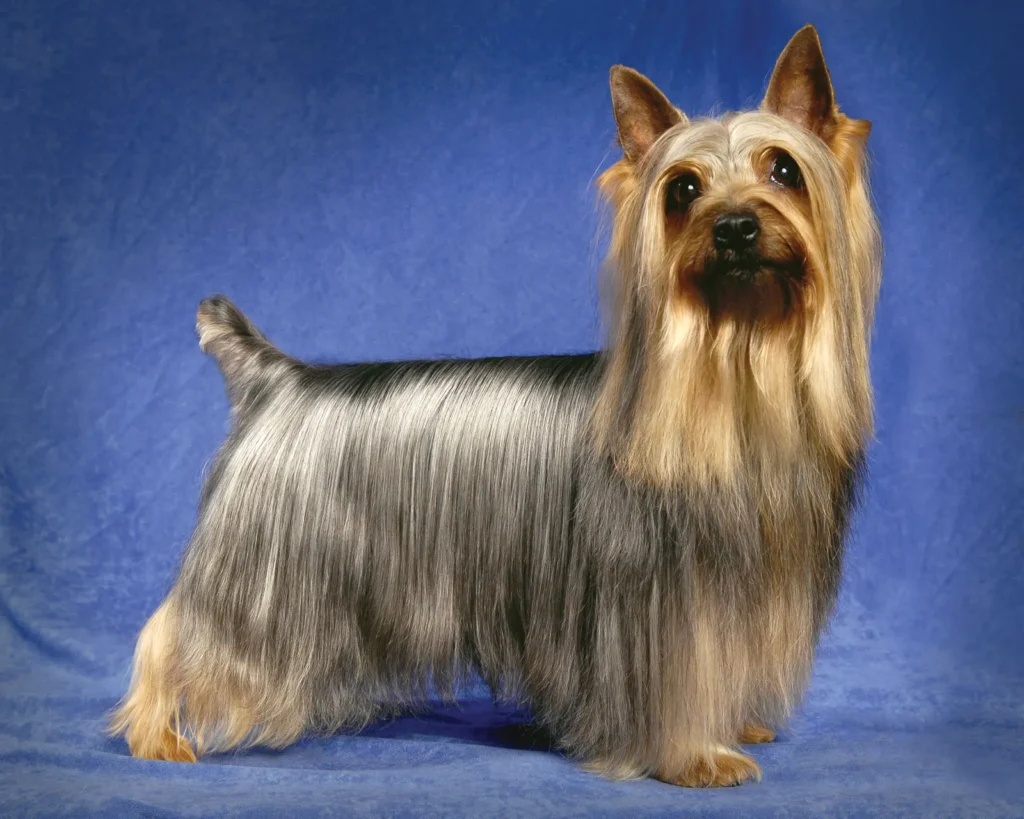
Description
They have V-shaped ears that are high on the head. Silky Terrier dogs have almond-shaped, intensely curious eyes that appear to have flawless black eyeliner. Their face is longer than that of their round-faced Yorkie cousin because of their short, wedge-shaped head. Their black nose is adorable and strong.
Origin/History
Early in the 20th century is when the silky terrier first appeared. To create the initial varieties of the breed, breeders in Australia crossed Yorkshire terriers with Australian terriers. Other breeds that might have played a role in its makeup include the cairn terrier, Dandie Dinmont, and Skye terrier.
There were once divergent breed standards in Australia. But by 1926, those had been combined. Prior to changing its name to Australian Silky Terrier in 1955, the breed was previously formerly known as the Sydney Silky Terrier.
In 1958, the year the Australian National Kennel Council was established, the breed was officially recognised. And one of its first tasks was to advise the American Kennel Club to adopt a breed standard. In 1959, the AKC officially recognised the breed as the silky terrier.
Temperament
The personalities of silky terriers are typically feisty and playful. They want to be occupied and are perceptive of their environment. Although they may exhibit stubbornness when it comes to training, their high intelligence also contributes to shaping their temperament.
Care
Silky terriers require regular training, socialization, and daily exercise. Depending on how long you maintain their coat, grooming them can also take a lot of time.

Exercise
The silky terrier needs regular exercise because it is an active but normally not hyper dog. To exercise your dog, set aside at least an hour each day for walks, treks, vigorous retrieve games, and other activities. Additionally, silky terriers can flourish in a variety of dog sports that can cognitively and physically challenge them.
When exercising outdoors, always keep your dog on a leash or in a secure enclosure. When faced with larger dogs, these small dogs usually don’t back down. Additionally, because of their prey drive, they could run off after squirrels and other small creatures. They should always be watched in a yard because they can dig and might get out by hiding beneath fences.
Grooming
The straight, glistening, and fine-textured coat of the silky terrier. It is very similar to human hair in that it grows continually. If you own this breed, regular grooming is an absolute need. Depending on how long the coat is, brush up to daily, but no less than twice a week. To remove knots and avoid mats, use a comb, pin brush, or soft-bristle brush.
A bath and a coat trim should be scheduled every four to six weeks. To protect the coat from tangling, you might wish to use a canine conditioner or grooming spray. At that time, you should also examine your dog’s nails to see whether they require trimming. At least once each week, check the animal’s ears for wax buildup and inflammation. And aims to daily brush its teeth.
Training
The intelligent silky terrier is quick to pick up new training methods. They can be obstinate about wanting to obey, though. To avoid the formation of undesirable habits, try to begin training at an early age. Use positive reinforcement techniques at all times. Additionally, be firm in your orders and don’t tolerate disrespectful behavior.
Start socializing your child early, too. Introduce your dog to various people and canines to increase its comfort in novel situations and prevent any territorial issues. Although silky terriers are normally adaptable to various living environments, they may exhibit reserve around strangers.
In addition, many silky terriers dislike being left alone for extended periods of time. They may engage in undesirable behaviors such excessive chewing or barking to act out their boredom or loneliness. An expert dog trainer or behaviorist can offer advice on how to leave your dog alone. However, it’s still preferable for a silky terrier to reside in a home where someone is there for the majority of the day.
Similar to this, excessive alert barking can also cause issues. Therefore, you’ll probably need to put some effort into teaching your dog when it’s suitable to bark and how to stop on command.
Diet and Nutrition
Ensure that your dog has access to fresh water at all times. And give your dog a high-quality, nutritionally sound diet. The best diet for tiny dog breeds is one that is delivered twice daily in metered meals. To be sure you are addressing your dog’s specific needs, you should always consult your veterinarian before changing the type of food or the quantity. A little dog’s body may easily gain a lot of weight from even a little extra weight, so keep an eye out for treats and any extra food to make sure your dog isn’t overeating.
Table





